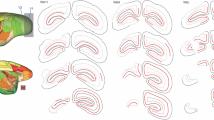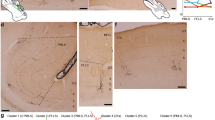Abstract
We used anterograde and retrograde transsynaptic pathway tracing techniques to reveal the retinal origin and the cortical termination of the expanded retino-geniculo-middle suprasylvian (MS) cortex pathway in adult cats which sustained lesions of areas 17 and 18 on the day of birth (P1) or at 1 month of age (P28). Following anterograde transsynaptic transport of tritiated amino acids from the eye, four major results were obtained: (1) a strong and specific pathway from retina through dorsal lateral geniculate nucleus (dLGN) to the posterior half of MS cortex was identified; this pathway is a substantial expansion of an insignificant pathway present in intact cats; (2) the terminus of the pathway was lower layer III and layer IV; (3) contralateral projections were stronger than ipsilateral projections; (4) projections in P28 cats were stronger than those in P1 cats. Following retrograde transsynaptic transport of WGA-HRP from posterior MS cortex, four additional results were obtained: (1) the pathway was enlarged and visuotopically organized; (2) the pathway arose primarily from α- and γ-retinal ganglion cells; (3) a small number of β-cells in P1 cats and a modest number in P28 cats also contribute to the pathway; (4) the combined numbers of γ- and β-cells relative to α-cells was greater in temporal retina than in nasal retina. The combined demonstration of both origin and terminus of the pathway with transsynaptic tracers argued strongly for high levels of coupling between primary and secondary pathway limbs in both P1 and P28 cats. This level of coupling, as well as other features of the pathway, have much in common with the retino-geniculo-17/18 pathway of intact cats. However, the retino-geniculo-MS system in P1 cats transmits primarily Y and W signals, in P28 cats X, Y, and W signals; whereas the retino-geniculo-17/18 pathway transmits primarily X and Y signals. These results have implications for understanding the repercussions of early visual cortex lesions in monkeys and humans.
Similar content being viewed by others
Author information
Authors and Affiliations
Additional information
Received: 17 November 1997 / Accepted: 10 February 1998
Rights and permissions
About this article
Cite this article
Payne, B., Lomber, S. Neuroplasticity in the cat’s visual system Origin, termination, expansion, and increased coupling of the retino-geniculo-middle suprasylvian visual pathway following early ablations of areas 17 and 18. Exp Brain Res 121, 334–349 (1998). https://doi.org/10.1007/s002210050466
Issue Date:
DOI: https://doi.org/10.1007/s002210050466




